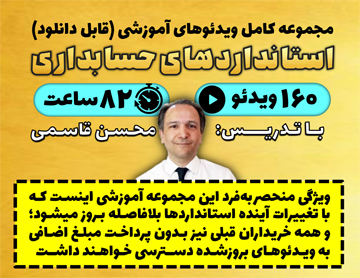تحصیل معکوس (استاندارد حسابداری 38 ترکیبهای تجاری (مصوب 1398) - پیوست ب: رهنمود بکارگیری)
ب19. تحصیل معکوس زمانی واقع میشود که واحد تجاری ناشر اوراق بهادار (واحد تحصیلکننده قانونی)، از نظر حسابداری و بر مبنای رهنمود مندرج در بندهای ب13 تا ب18، به عنوان واحد تحصیلشده تشخیص داده میشود. یک واحد تجاری که منافع مالكانه آن تحصیل میشود (واحد تحصیلشده قانونی)، از نظر حسابداری باید واحد تحصیلکننده باشد تا معامله، به عنوان تحصیل معکوس در نظر گرفته شود. برای مثال، برخی مواقع، تحصیل معکوس زمانی واقع میشود که یک واحد تجاری که سهامی عام نیست، در نظر دارد به واحد تجاری سهامی عام تبدیل شود اما تمایلی به ثبت سهام در بورس اوراق بهادار ندارد. بدین منظور، واحد تجاری که سهامی عام نیست، ترتیبی اتخاذ میكند که یک واحد تجاری سهامی عام، منافع مالكانه آن را در ازای منافع مالكانه واحد تجاری سهامی عام تحصیل كند. در این مثال، واحد تجاری سهامی عام، واحد تحصیلکننده قانونی محسوب میشود زیرا حقوق مالكانه خود را منتشر کرده است و واحد تجاری که سهامی عام نیست، واحد تحصیلشده قانونی محسوب میشود زیرا حقوق مالكانه آن تحصیل شده است. با وجود این، بکارگیری رهنمود مندرج در بندهای ب13 تا ب18، منجر به تشخیص موارد زیر میشود:
- الف. از نظر حسابداری، واحد تجاری سهامی عام به عنوان واحد تحصیلشده تلقی میشود (واحد تحصیلشده حسابداری)؛ و
- ب. از نظر حسابداری، واحد تجاری که سهامی عام نیست، به عنوان واحد تحصیلکننده تلقی میشود (واحد تحصیلکننده حسابداری).
واحد تحصیلشده حسابداری، باید تعریف فعالیت تجاری را احراز کند تا معامله به عنوان تحصیل معكوس محسوب شود، و تمام اصول شناخت و اندازهگیری مندرج در این استاندارد، شامل الزامات شناخت سرقفلی، در مورد آن کاربرد دارد.
منابع آموزشی مربوط:
- حسابداری تحصیل معکوس توسط یک شرکت فهرستشده در بورس، موسسه گرنت تورنتون (ترجمه فارسی)
- حسابداری تحصیل معکوس توسط یک شرکت فهرستشده در بورس، موسسه گرنت تورنتون (متن اصلی انگلیسی)
- تشریح تحصیل معکوس، موسسه گرنت تورنتون (متن اصلی انگلیسی)
Reverse acquisitions - IFRS 3 Business Combinations
B19. A reverse acquisition occurs when the entity that issues securities (the legal acquirer) is identified as the acquiree for accounting purposes on the basis of the guidance in paragraphs B13–B18. The entity whose equity interests are acquired (the legal acquiree) must be the acquirer for accounting purposes for the transaction to be considered a reverse acquisition. For example, reverse acquisitions sometimes occur when a private operating entity wants to become a public entity but does not want to register its equity shares. To accomplish that, the private entity will arrange for a public entity to acquire its equity interests in exchange for the equity interests of the public entity. In this example, the public entity is the legal acquirer because it issued its equity interests, and the private entity is the legal acquiree because its equity interests were acquired. However, application of the guidance in paragraphs B13–B18 results in identifying:
The accounting acquiree must meet the definition of a business for the transaction to be accounted for as a reverse acquisition, and all of the recognition and measurement principles in this IFRS, including the requirement to recognise goodwill, apply. |






دیدگاه خود را بنویسید